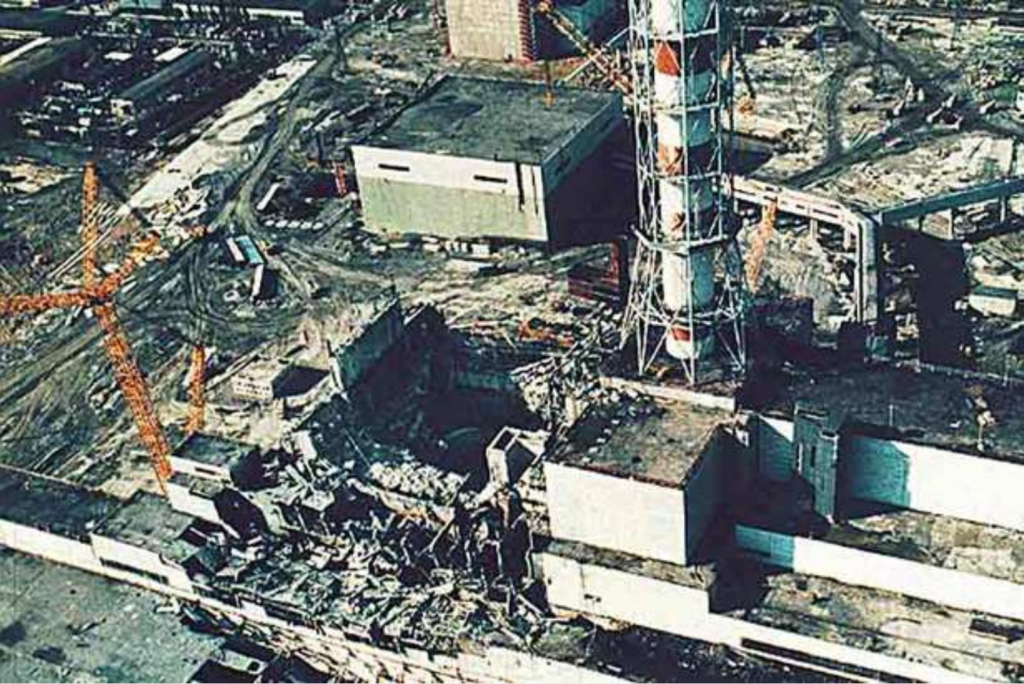On April 26, 1986, a sudden surge of power during a reactor systems test destroyed Unit 4 of the nuclear power station at Chernobyl, Ukraine, in the former Soviet Union. The accident and the fire that followed released massive amounts of radioactive material into the environment.
Emergency crews responding to the accident used helicopters to pour sand and boron on the reactor debris. The sand was to stop the fire and additional releases of radioactive material; the boron was to prevent additional nuclear reactions. A few weeks after the accident, the crews completely covered the damaged unit in a temporary concrete structure, called the “sarcophagus,” to limit further release of radioactive material. The Soviet government also cut down and buried about a square mile of pine forest near the plant to reduce radioactive contamination at and near the site. Chernobyl’s three other reactors were subsequently restarted but all eventually shut down for good, with the last reactor closing in 1999. The Soviet nuclear power authorities presented their initial accident report to an International Atomic Energy Agency meeting in Vienna, Austria, in August 1986.
After the accident, officials closed off the area within 30 kilometers (18 miles) of the plant, except for persons with official business at the plant and those people evaluating and dealing with the consequences of the accident and operating the undamaged reactors. The Soviet (and later on, Russian) government evacuated about 115,000 people from the most heavily contaminated areas in 1986, and another 220,000 people in subsequent years (Source: UNSCEAR 2008, pg. 53).
Health Effects from the Accident

The Chernobyl accident’s severe radiation effects killed 28 of the site’s 600 workers in the first four months after the event. Another 106 workers received high enough doses to cause acute radiation sickness. Two workers died within hours of the reactor explosion from non-radiological causes. Another 200,000 cleanup workers in 1986 and 1987 received doses of between 1 and 100 rem (The average annual radiation dose for a U.S. citizen is about .6 rem). Chernobyl cleanup activities eventually required about 600,000 workers, although only a small fraction of these workers were exposed to elevated levels of radiation. Government agencies continue to monitor cleanup and recovery workers’ health. (UNSCEAR 2008, pg. 47, 58, 107, and 119)
The Chernobyl accident contaminated wide areas of Belarus, the Russian Federation, and Ukraine inhabited by millions of residents. Agencies such as the World Health Organization have been concerned about radiation exposure to people evacuated from these areas. The majority of the five million residents living in contaminated areas, however, received very small radiation doses comparable to natural background levels (0.1 rem per year). (UNSCEAR 2008, pg. 124-25) Today the available evidence does not strongly connect the accident to radiation-induced increases of leukemia or solid cancer, other than thyroid cancer. Many children and adolescents in the area in 1986 drank milk contaminated with radioactive iodine, which delivered substantial doses to their thyroid glands. To date, about 6,000 thyroid cancer cases have been detected among these children. Ninety-nine percent of these children were successfully treated; 15 children and adolescents in the three countries died from thyroid cancer by 2005. The available evidence does not show any effect on the number of adverse pregnancy outcomes, delivery complications, stillbirths or overall health of children among the families living in the most contaminated areas. (UNSCEAR 2008, pg. 65)
Experts expected that some cancer deaths might eventually be attributed to Chernobyl over the lifetime of the emergency workers, evacuees and residents living in the most contaminated areas. While cancer deaths have generally been far lower than initial speculations of tens of thousands of radiation-related deaths, a recent study of a cohort of emergency workers found a statistically significant relative risk of solid cancer incidence and mortality. (Kaschcheev, 2015)
There are also psycho-social impacts on residents and evacuees from the disaster including higher rates of depression, alcoholism and anxiety over potential health effects. Residents report very negative self-assessments of health, unexplained physical symptoms, and expectations of a short life. (IAEA, 2006, and World Health Organization, 2016)


